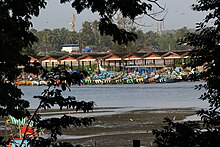Arakkal kingdom
This article needs additional citations for verification. (May 2021) |
Arakkal Kingdom | |||||||||
|---|---|---|---|---|---|---|---|---|---|
| 1545–1819 | |||||||||
| Capital | British India | 1819 | |||||||
| |||||||||

Arakkal Kingdom was a
The Bibi received no special treatment after the treaties of
The king's palace, which he purchased from the Dutch in 1663, was named
Origins




As per legend, the last ruler of the
Perumal's nephew Mabeli was an
Another legend is that the daughter of
The British Military was very eager to make
Location
The palace is three kilometers from Kannur,

Ali Rajas and Arakkal Beevis

The Arakkal family followed a
Hameed Hussain Koyamma Ali Raja, became the new head of the Arakkal royal family on 2nd Dec 2021.[9]
History
There had been considerable trade relations between
Thus history of Muslims in Kerala is closely intertwined with the history of Muslims in the nearby
By 1909, Arakkal rulers had lost Kannur and the Cannanore Cantonment. By 1911, there was a further decline with the loss of chenkol (sceptre) and udaval (sword).
During the time of the
Thalassocracy in the Arabian Sea
The Arakkal Ali Rajas sure put their navy to good use. Ali Moossa, the fifth ruler is said to have conquered some of the Maladweep (Maldives) islands in 1183-84 CE. Generally, these Rajas were known by different titles, viz. Adi Raja (the first king), Azhi Raja (Lord of the seas), Aliraja (noble king), and Aali Raja, which shows the origin from the first king Mammali. The connection with the Maldives and Lakshadweep (Laccadives) was well-known to the Portuguese and other Europeans, with the 9° channel separating Minicoy from the Laccadive group being referred to as the 'Mammali’s Channel'. Even during the beginning of the 16th century, the king of Maldives was a tributary of this House. The Jagir of Laccadive islands, received by the Ali Rajas from Kolathiris in the 16th century, enhanced the status of the House.[26] Kannur (Cannanore) could effectively be characterised as a Muslim thalassocracy, acknowledging that the religious identity of the Ali Rajas had a significant role in their political prominence. A link can be made of the income from importing horses from West Asia to the political power of the Ali Rajas throughout the sixteenth century.[27]

Relations with the Kingdom of Mysore
After being appointed the Naval Chief of Hyder Ali's army, Ali Raja Kunhi Amsa II's first course of action was to capture the unfortunate
Foreign relations of the Arakkal
In the year 1777 a letter was sent to the
Arakkal Museum

The
The Arakkalkettu is owned by the Arakkal Trust, which includes some members Arakkal royal family. The government had taken a keen interest in preserving the heritage of the Arakkal Family, which had played a prominent role in the history of
Reigning Arakkal rajas and Arakkal beevis
- Ali Raja Ali (1545–1591)
- Ali Raja Abubakar I (1591–1607)
- Ali Raja Abubakar II (1607–1610)
- Ali Raja Muhammad Ali I (1610–1647)
- Ali Raja Muhammad Ali II (1647–1655)
- Ali Raja Kamal (1655–1656)
- Ali Raja Muhammad Ali III (1656–1691)
- Ali Raja Ali II (1691–1704)
- Ali Raja Kunhi Amsa I (1704–1720)
- Ali Raja Muhammad Ali IV (1720–1728)
- Ali Raja Bibi Harrabichi Kadavube (1728–1732)
- Ali Raja Bibi Junumabe I (1732–1745)
- Ali Raja Kunhi Amsa II (1745–1777)
- Ali Raja Bibi Junumabe II (1777–1819)
See also
References
- ISBN 978-81-8264-046-7
- ^ a b Malabar Manual, Volume 1, William Logan
- ^ Kerala Muslim History – P A Syed Mohammed
- ^ A. Sreedhara Menon (1967). A Survey of Kerala History. Sahitya Pravarthaka Co-operative Society. p. 204.
- ^ N. S. Mannadiar (1977). Lakshadweep. Administration of the Union Territory of Lakshadweep. p. 52.
- ^ Ke. Si. Māmmanmāppiḷa (1980). Reminiscences. Malayala Manorama Pub. House. p. 75.
- ^ "Madayi Mosque". Archived from the original on 29 September 2013. Retrieved 25 September 2013.
- ^ a b c Kerala District Gazetteers: Malappuram, A. Sreedhara Menon, Superintendent of Govt. Presses, 1972, p. 92
- ^ "Kerala: Head of Arakkal royal family dies | Kozhikode News - Times of India". The Times of India. 30 November 2021.
- JSTOR 2800388.
- ^ P. P., Razak Abdul "Colonialism and community formation in Malabar: a study of muslims of Malabar" Unpublished PhD thesis (2013) Department of History, University of Calicut [1]
- ^ Sethi, Atul (24 June 2007). "Trade, not invasion brought Islam to India". Times of India. Retrieved 24 September 2014.
- ^ Katz 2000; Koder 1973; Thomas Puthiakunnel 1973; David de Beth Hillel, 1832; Lord, James Henry 1977.
- ISBN 9788190250511.
- ISBN 9781136704918.
- ^ Minu Ittyipe; Solomon to Cheraman; Outlook Indian Magazine; 2012
- ISBN 9780765601049.
- ISBN 978-0-231-70024-5. Retrieved 24 July 2012.
- ISBN 978-90-04-07929-8. Retrieved 25 July 2012.
- ISBN 978-81-903887-8-8. Retrieved 25 July 2012.
- ^ Prange, Sebastian R. Monsoon Islam: Trade and Faith on the Medieval Malabar Coast. Cambridge University Press, 2018. 98.
- ^ Pg 58, Cultural heritage of Kerala: an introduction, A. Sreedhara Menon, East-West Publications, 1978
- ^ "History". lakshadweep.nic.in. Archived from the original on 14 May 2012. Retrieved 1 August 2012.
- ^ Charles Alexander Innes (1908). Madras District Gazetteers Malabar (Volume-I). Madras Government Press. pp. 423–424.
- ^ Kerala Source Book. India, Cruz Consultants for Kerala NRI Association, 2003. p25.
- JSTOR 44138504. Retrieved 12 January 2024.
- ^ Prange, Sebastian. Monsoon Islam: Trade and Faith on the Medieval Malabar Coast.
- ^ Logan, William. Malabar Manual. Vol. 1. p. 408.
- ISBN 9004106324.


